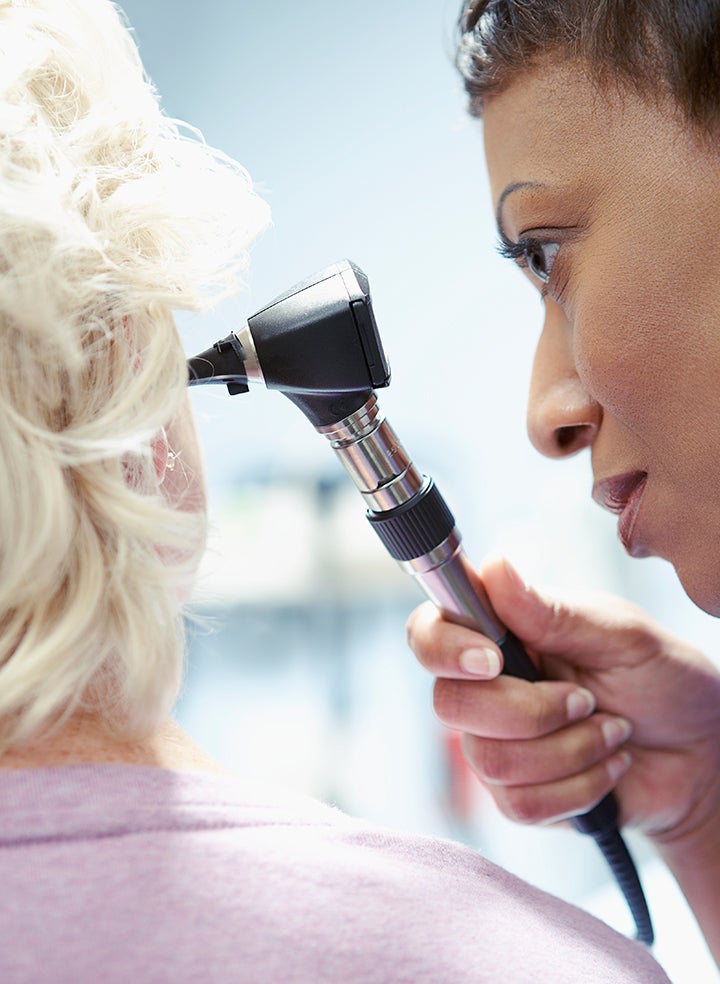Removal of Earwax Buildup
Earwax buildup can feel uncomfortable and impede your hearing. Learn the types of treatment for earwax removal.

Earwax, also known as cerumen, is a natural, waxy oil produced by glands in the ear canals. It plays an important role in preventing dirt, viruses, and bacteria from entering your body through your ears.
After earwax is produced, it normally drains out of the ear canal to the outer ear, where it dries up and falls away. Under most circumstances, your ear canals do not need to be cleaned. However, earwax can sometimes build up and block the ear canal. This blocked or impacted earwax can cause uncomfortable symptoms, including hearing loss.
What are the symptoms of earwax buildup?
Earwax buildup can be uncomfortable and may cause sudden or partial hearing loss (usually temporarily). Other symptoms include earaches, a sense of fullness in the ear, and hearing a ringing or buzzing sound in the ear.
Earwax buildup can also result in infections. Symptoms of infection include severe or persistent pain in your ear, drainage from your ear, hearing loss, dizziness, fever, coughing, and an odor coming from your ear. If you have signs of an ear infection, visit a medical provider for treatment.
What causes earwax buildup?
One cause of earwax buildup is when your glands produce more wax than needed. This can result in wax building up faster than it can drain from the ear, eventually resulting in blockage.
The most common reason for earwax impaction, however, is at-home attempts at earwax removal. When cotton swabs, rolled-up napkins, bobby pins or other objects are inserted into the ears, they often push earwax further into the ear, causing impaction. Inserting objects into the ears can also cause infection, damage to the eardrums, and hearing loss.
Earwax impaction is more likely to occur when you frequently use headphones or earplugs, which can prevent earwax from draining out. Older adults are also at a higher risk of earwax impaction and associated hearing loss.
Can excess earwax be removed at home?
There are several at-home remedies for built-up or impacted earwax removal, but some of them can be dangerous. It is best to consult a medical professional before attempting to remove earwax at home.
You should never try to remove earwax by inserting objects into the ear. Cotton swabs should be used on the outside of the ear only.
Ear candling is also not recommended. Despite claims that this home remedy pulls earwax out of the ear, studies have not shown this to be true. In fact, ear candling can cause serious blockages when the candle wax is accidentally deposited in the ear. Other risks of ear candling include perforated eardrums, burns, and hearing loss.
To remove earwax at home, you can first soften the earwax by adding a few drops of mineral oil, baby oil, carbamide peroxide, hydrogen peroxide or glycerin to your ear. After being softened, the earwax may be able to drain without further help.
If the earwax doesn’t drain on its own, the softened wax will be easier to remove by irrigation. This can be done at your doctor’s office or using an over-the-counter kit. Always use a kit designed specifically for ear irrigation, and follow the directions carefully. Never irrigate your ear if you have had an ear injury or a medical procedure done on your ear.
You can also ask a healthcare provider to do a professional earwax removal. This is the safest and most effective way to remove excess earwax.
What can I expect when I visit the doctor for earwax removal?
At WellNow, every visit starts with a medical history and exam. As part of your examination for earwax buildup, the medical provider will use an otoscope to look inside your ears. If earwax has built up, your provider may recommend ear irrigation, unless you have a condition that could be affected by using the ear wash system.
If ear irrigation is indicated, the medical provider or a technician will thoroughly wash the inside of your ear to remove the excess earwax. Using an instrument called an elephant ear washer or a specially designed syringe; our staff will use warm water to rinse the inside of your ear.
You may be able to see the earwax that has been removed. It will be clear, yellow or brown in color. Once the irrigation is complete, your provider will look inside your ears again to check that the buildup is gone.
If there is still some excess earwax remaining after irrigation, your provider may use an ear curette to remove the wax manually. This procedure should only be performed by a licensed healthcare provider.
How can I find a provider for earwax removal?
To find an earwax removal doctor or medical provider, consult your primary care physician or visit a WellNow clinic any day of the week. You can find a clinic near you with our easy-to-use location finder. Make an appointment or walk-in any time during our extended hours. With more than 40 locations and a dedicated team of healthcare professionals, we’re ready to help!
